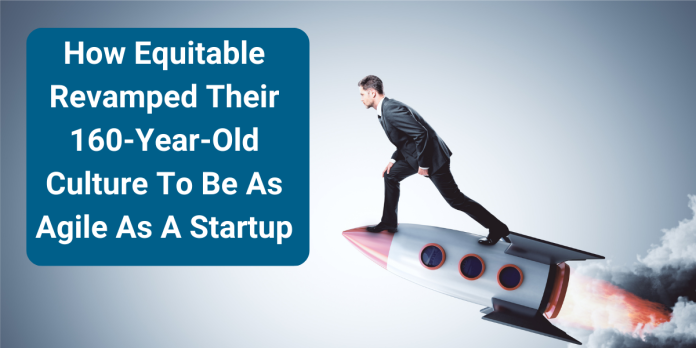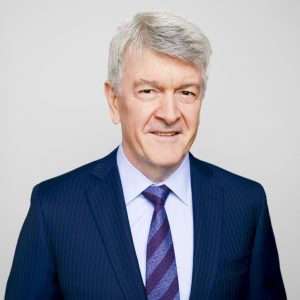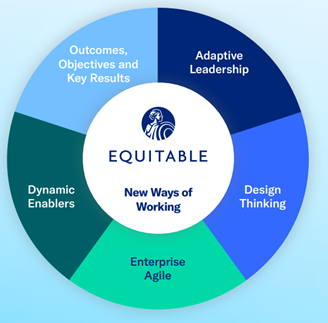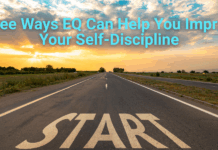
“Equitable is, at the same time, a 160-year-old organization and a five-year-old organization.” —Mark Pearson, CEO of Equitable
How do you take a company that’s 160 years old and overhaul its culture to be as nimble and productive as a five-year-old startup?
 I likely would have answered, “That’s not possible,” at least up until I had the chance to interview the CEO of Equitable, Mark Pearson.
I likely would have answered, “That’s not possible,” at least up until I had the chance to interview the CEO of Equitable, Mark Pearson.
Equitable, founded in 1859, is a financial services company that provides retirement planning solutions and life insurance. After being a subsidiary of AXA for twenty-six years, they spun off and IPO’d in 2018 for $2.8 billion, naming Mark Pearson their CEO.
Under Pearson’s leadership, Equitable treated this moment as an opportunity to revamp their culture to make it more agile. They carved out and codified their company culture in an initiative called “New Ways of Working,” or NWOW.
Within a couple years of rolling out NWOW, Equitable saw substantial, measurable change in their culture. Notable examples include:
- A massive increase in enterprise-wide agility: For example, where they previously had twenty-six layers of management, they cut that down to only five.
- Key metrics skyrocketed: Psychological safety scores increased 25%, work-life balance increased 16%, and performance feedback increased 14%.
- They built and promoted a diverse pipeline of leaders: Their TAP program for black employees has had a promotion rate as high as 83% for a given cohort with an average of 52% across five cohorts.
Pearson described the genesis of their shift toward an agile culture, saying, “Equitable is, at the same time, a 160-year-old organization and a five-year-old organization. The 160-year-old brings our earnings, which are two billion a year, that's nice. But, we have the energy of a five-year-old company, which is so unique.”
Here’s how Pearson and Equitable went about transforming their culture.

Going Agile: Equitable Defined The Culture They Wanted And Acted Fast To Make It Reality
We knew, and I knew, that this was the opportunity to really build the house we wanted to live in. —Mark Pearson, CEO of Equitable
One of the first questions Pearson asked as Equitable spun off from AXA was this: “How are we going to establish Equitable as a standalone entity?”
The answer lay in a cultural transformation. “It became very clear to us early on that we had to change the culture, and we had to change the way it worked,” Pearson said. “It was a bit like a young adult coming of age and moving out of their parent’s house. Ultimately, you must be able to stand on your own. How do you want to live your life? What's the house you want to build now?”
One of the central questions Pearson asked as Equitable set out to “build their house” was this: “What was the new way of working we could bring into our organization to raise the metabolism, to not just meet the challenge of our IPO, but to thrive in it?”
For answers, Equitable turned to other companies, books, and experts. “One of the companies we saw was a company from New Zealand called Spark. It's a telco company that had gone fully agile,” Pearson said. “We also spent some time with ING, the bank, and we learned more about what USAA was doing in some of their customer areas. And the result of all of this reading, research, and early-stage partnership with consultancies, was that we came up with a five-pillar framework for New Ways of Working.”
The Five Pillars of NWOW

To clearly define their shift in culture, Equitable put together five New Ways of Working. Together, the five ways form an interconnected, mutually reinforcing system:
Way #1: Outcomes, Objectives, and Key Results. Pearson described this first pillar saying, “This is about what success looks like, having committed goals, and defining how we’re going to measure success. An important piece of this is having ‘moonshots.’ The concept of moonshots frees people up. We ask, ‘What if we could really swing for the fences? What would we see?’”
Way #2: Adaptive Leadership. “The second pillar,” Pearson said, “is adaptive leadership. How do we find that balance between freedom of decision-making and central control? Because in an insurance group like ours, risk management is absolutely crucial. It's like a nuclear weapon for us. It can really blow the place up.”
Way #3: Design Thinking. “The third pillar is design thinking,” Pearson said, “and the concept is to create minimal viable products that you can test with end users as quickly as you can. It’s about launching your minimum viable products, then testing, changing, testing, changing, and so on.”
Way #4: Enterprise Agile. “The fourth leg is enterprise agile. This is about being agile, but it’s also about doing agile. There's a sort of methodology there. I know IT departments have been doing this for some time, but we've sort of brought it into the mainstream. We do daily standup ceremonies for 15 minutes where team members read out two-week sprint cycles. That's the doing agile piece, and it brings teams very close together.”
Way #5: Dynamic Enablers. “The fifth leg is the dynamic enablers. This is about moving the organization as much as we can to skills-based. It’s about really flattening the organization. When I first came, there were 26 levels in the company. We flattened that down to five. People contribute based on their skills and competencies, not on their title.”
TAP: Talent Accelerator Program for Black Employees
We took the NWOW principles and built out a leadership training program to move black individual contributor employees into leadership positions. —Mark Pearson, CEO of Equitable
From the foundational pillars of their New Ways of Working program, Equitable built out specialized programs.
One of their most successful examples is their Talent Accelerator Program (TAP) for black employees. Pearson described how TAP came to be, saying, “Right in the middle of our rollout of NWOW, America was shaken and shocked by the George Floyd killing. We decided that this rollout of new ways of working and the new skills we were going to build was a way in which we could get a better, more representative pipeline of leaders.”
As a part of NWOW, Equitable was already teaching employees leadership skills, coaching skills, problem-solving, and how to work in teams. “When we looked inside the organization,” Pearson pointed out, “we had a gap in representation. Whenever we wanted to make a leadership appointment, we didn't have a representative population of black candidates. And that gap is being closed now.”
Already, 52% of TAP participants have been promoted since going through the program.
Pearson’s Advice for Organizations Who Want to Revamp Their Culture
‘Burn the Boats.’ “One of the things in our research with the handful of other companies that have done this one was this concept of burn the boats,” Pearson said. “You have to be committed. You have to drive the initiative from the top down and convey the message that we're going for this, this is important, and this is an existential issue for us. You can’t tell the organization that ‘we're giving this a trial.’ Instead, we said, “This is going to be a change in how we work. This is a change in culture. This is not a test or a pilot.”
Get the Consultants out Early. “As soon as you can, have your own people lead your cultural shift. There are experts out there, and you should tap into their knowledge. But, it's about getting that knowledge and doing it your way, very, very quickly. I can't tell you how many times I've heard that's the consultant’s strategy, that's the consultant’s idea…The minute it's not an Equitable person driving the culture, I think it's going to die because people just wait for the consultants to go.” Instead, Pearson and Equitable created their own internal team, the Innovation and Design Office (IDO), which actively spearheaded their changes and cultural transformation.






